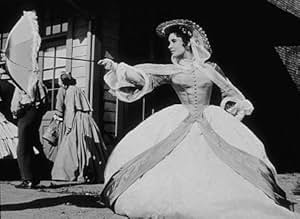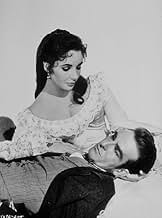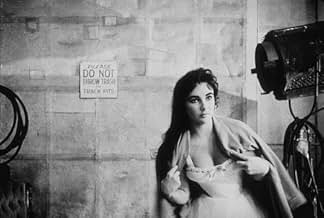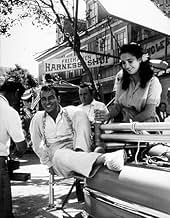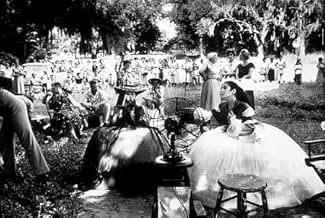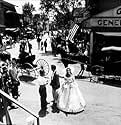NOTE IMDb
6,3/10
4,6 k
MA NOTE
Un poète et professeur diplômé tombe amoureux d'une jeune Sudiste mais la Guerre de Sécession va chambouler leurs existences.Un poète et professeur diplômé tombe amoureux d'une jeune Sudiste mais la Guerre de Sécession va chambouler leurs existences.Un poète et professeur diplômé tombe amoureux d'une jeune Sudiste mais la Guerre de Sécession va chambouler leurs existences.
- Réalisation
- Scénario
- Casting principal
- Nommé pour 4 Oscars
- 1 victoire et 8 nominations au total
Fred Aldrich
- Townsman
- (non crédité)
Ruth Attaway
- Parthenia
- (non crédité)
John Barton
- Townsman
- (non crédité)
Oliver Blake
- Jake - Bartender
- (non crédité)
Nesdon Booth
- Spectator
- (non crédité)
Avis à la une
John Wickliff Shawnessey (Montgomery Clift) and his girlfriend Nell Gaither (Eva Marie Saint) are part of the 1859 graduating class in Raintree County, Indiana. He is taken with visiting socialite Susanna Drake (Elizabeth Taylor) from a wealthy New Orleans family. Later, she returns to Raintree informing him of her pregnancy. He is honor bound to marry her.
This is trying to be a new Gone with The Wind but it's rather sluggish. The first two hours are a melodrama. Montgomery Clift is a functional heroic lead. Susanna's race heritage is somewhat interesting but her craziness distracts from its sincere seriousness. It could have been a nuanced dissection of race in the south. Like the blackface moment, the movie skirts the issue by blowing it up. Then comes a half hour of war epic. The war epic is not that epic. It's a lighter version of the burning of Atlanta. All in all, it isn't Gone with the Wind. It's only a breeze.
This is trying to be a new Gone with The Wind but it's rather sluggish. The first two hours are a melodrama. Montgomery Clift is a functional heroic lead. Susanna's race heritage is somewhat interesting but her craziness distracts from its sincere seriousness. It could have been a nuanced dissection of race in the south. Like the blackface moment, the movie skirts the issue by blowing it up. Then comes a half hour of war epic. The war epic is not that epic. It's a lighter version of the burning of Atlanta. All in all, it isn't Gone with the Wind. It's only a breeze.
This soap opera really sprawls over the years before and after the Civil War. Montgomery Clift is a quiet homegrown college graduate in mutual love with pretty young Eva Marie Saint. They seem fated for each other. They'll probably be married, raise a number of surviving children, and live in a white two-story house on the outskirts of Fairhaven in Raintree County, Indiana. But then, the luscious Southern belle, Elizabeth Taylor, visits Fairhaven. She and Clift fall in love forever after.
But dark Elizabeth is Veronica to Saint's blond Betty. Or is it the other way around? No matter. Anyway they have contrasting personalities: the intensely passionate Taylor and the winsome and innocent Saint. Saint, for instance, would never dream of putting out for handsome, intelligent, and sensitive Monty, whereas Taylor does so on their second or third date and then LIES to him about having gotten pregnant. He doesn't mind one way or the other, besotted as he is.
I don't know whether it's worthwhile trying to get through the plot. It's probably been done elsewhere, and I'm too tired to trace the trips, the outbursts of anger and guilt, Sherman's march through Georgia, and the finale, which no power on earth could force me to reveal. Much of it has to do with the fear of having a touch of the tar brush in one's blood.
But I must say, New Orleans is given rather a bad rap as a representative Southern city. It wasn't like any of the others. It had an animated and rich multi-ethnic heritage at the time -- American, French, Spanish, Caribbean, and African. Edgar Degas visited French relatives there late in the '19th century. Slaves of course but not nearly as brutal a system as elsewhere. William Tecumseh Sherman taught at Louisiana State Seminary of Learning & Military Academy, later to become Louisiana State University.
Others have claimed that it was easy to tell the difference between pre- and post-accident scenes of Montgomery Clift but I couldn't. As for the accident, Clift was doing booze and other substances to excess on a daily basis during the shooting. I mean, eating steaks he'd spilled on the floor and so on. After an evening at Liz Taylor's manse perched on a hill, he drove drunkenly down the winding road and didn't quite make it.
Neither the accident nor the booze seemed to interfere with his acting, although the part of the pathetic loner in "A Place in the Sun" suited him better than the idealist he's forced to portray here. Elizabeth Taylor is blindingly beautiful. Many of her films cast her has a frustrated nut job. Eva Marie Saint has the more sympathetic role as the unspectacular girl from home who never manages to shrug off her love for Clift.
It's long. It has an overture and even an entr'acte, evocative photography by Robert Surtees, and a lushly orchestrated but fulsome score by Johnny Green. It's no "Gone With the Wind," though, partly because it substitutes anguish for laughs.
But dark Elizabeth is Veronica to Saint's blond Betty. Or is it the other way around? No matter. Anyway they have contrasting personalities: the intensely passionate Taylor and the winsome and innocent Saint. Saint, for instance, would never dream of putting out for handsome, intelligent, and sensitive Monty, whereas Taylor does so on their second or third date and then LIES to him about having gotten pregnant. He doesn't mind one way or the other, besotted as he is.
I don't know whether it's worthwhile trying to get through the plot. It's probably been done elsewhere, and I'm too tired to trace the trips, the outbursts of anger and guilt, Sherman's march through Georgia, and the finale, which no power on earth could force me to reveal. Much of it has to do with the fear of having a touch of the tar brush in one's blood.
But I must say, New Orleans is given rather a bad rap as a representative Southern city. It wasn't like any of the others. It had an animated and rich multi-ethnic heritage at the time -- American, French, Spanish, Caribbean, and African. Edgar Degas visited French relatives there late in the '19th century. Slaves of course but not nearly as brutal a system as elsewhere. William Tecumseh Sherman taught at Louisiana State Seminary of Learning & Military Academy, later to become Louisiana State University.
Others have claimed that it was easy to tell the difference between pre- and post-accident scenes of Montgomery Clift but I couldn't. As for the accident, Clift was doing booze and other substances to excess on a daily basis during the shooting. I mean, eating steaks he'd spilled on the floor and so on. After an evening at Liz Taylor's manse perched on a hill, he drove drunkenly down the winding road and didn't quite make it.
Neither the accident nor the booze seemed to interfere with his acting, although the part of the pathetic loner in "A Place in the Sun" suited him better than the idealist he's forced to portray here. Elizabeth Taylor is blindingly beautiful. Many of her films cast her has a frustrated nut job. Eva Marie Saint has the more sympathetic role as the unspectacular girl from home who never manages to shrug off her love for Clift.
It's long. It has an overture and even an entr'acte, evocative photography by Robert Surtees, and a lushly orchestrated but fulsome score by Johnny Green. It's no "Gone With the Wind," though, partly because it substitutes anguish for laughs.
Plot-- Before the Civil War, a pair of lovers marry and move from the North to the South where John finds out that new wife Susanna is haunted by a childhood trauma. Returning North they get caught up in the War, while Susanna becomes dysfunctional. What will John do, especially when lovelorn Neil (Saint) is still available.
Oh my, I guess MGM had too big an investment not to release this swollen turkey. As I recall, it got a lot of hyped promotion in '57. For fans, like me, of the Taylor-Clift romantic pairing (A Place In The Sun, {1951}), this misguided sequel should be avoided like the plague. Taylor does her best in a part disjointed badly by a perforated script, while Clift struggles manfully following his traumatic road accident. Also undercutting the romantic theme is the absence of close-ups emphasizing the vital tender emotions. I suspect that was because of Clift's mid-filming disfigurement. Nonetheless, the first 2-hours of personal relationship is further pulled down by impersonal staging. And since so much of the film follows the romance, recovery is near impossible.
The movie does come alive when Lee Marvin's blustery rough-neck comes on-screen. Clearly, he's on his way up the Hollywood ladder. But pity poor Eva Marie Saint of On The Waterfront (1954) whose sterling acting chops are almost totally wasted as the lonely heart in waiting. Where the movie does shine, as others point out, is in the visuals of costuming and massed army men. In short, the sort of production features big-budget MGM typically excelled at. I also like the effort at using the Raintree symbolism to bind the film into a poetic whole. Too bad, the script muddies that with sporadic development.
Anyway, it's regrettable that such a prestige production got undercut by factors not entirely under studio control. I suspect there's a practical moral at work here, but I'm not sure what it is.
Oh my, I guess MGM had too big an investment not to release this swollen turkey. As I recall, it got a lot of hyped promotion in '57. For fans, like me, of the Taylor-Clift romantic pairing (A Place In The Sun, {1951}), this misguided sequel should be avoided like the plague. Taylor does her best in a part disjointed badly by a perforated script, while Clift struggles manfully following his traumatic road accident. Also undercutting the romantic theme is the absence of close-ups emphasizing the vital tender emotions. I suspect that was because of Clift's mid-filming disfigurement. Nonetheless, the first 2-hours of personal relationship is further pulled down by impersonal staging. And since so much of the film follows the romance, recovery is near impossible.
The movie does come alive when Lee Marvin's blustery rough-neck comes on-screen. Clearly, he's on his way up the Hollywood ladder. But pity poor Eva Marie Saint of On The Waterfront (1954) whose sterling acting chops are almost totally wasted as the lonely heart in waiting. Where the movie does shine, as others point out, is in the visuals of costuming and massed army men. In short, the sort of production features big-budget MGM typically excelled at. I also like the effort at using the Raintree symbolism to bind the film into a poetic whole. Too bad, the script muddies that with sporadic development.
Anyway, it's regrettable that such a prestige production got undercut by factors not entirely under studio control. I suspect there's a practical moral at work here, but I'm not sure what it is.
M-G-M assigned some pretty heavy-hitters to cobble together this almost indigestible attempt to tell a Civil War story without a producer like David O. Selznick to insist that the whole thing should somehow come together. Other comments on this site tell the sad story of miscasting, a seemingly unfocused script, apparently disinterested direction and the obvious tragedy of Montgomery Clift's catastrophic automobile accident during production and its effect on all the performances he was to give thereafter.
Elizabeth Taylor is about the only central player who emerges relatively unscathed and her Academy Award nomination was deserved (and certainly more worthy of the Oscar she did win for "BUtterfield 8".)
I bought reserved seat tickets for this before its initial engagement began and the reviewers' generally negative appraisals were available. M-G-M's new big screen process, MGM Camera 65 ("Window of the World" as they termed it, used only once again by the studio for "Ben-Hur"), afforded a handsome showcasing of all the expense lavished upon this production, but, even as a teenager, I squirmed in my seat as its oh-so-lengthy reels unspooled and I left the theater regretting that its makers hadn't somehow achieved something memorable for its quality and dramatic impact, rather than for its longueurs. Johnny Green's score (and Nat King Cole's rendition of the title song) did sound awfully good over the stereophonic sound system at that Beverly Hills, California theater and that's one aspect of this disappointment that is now probably lost forever.
Elizabeth Taylor is about the only central player who emerges relatively unscathed and her Academy Award nomination was deserved (and certainly more worthy of the Oscar she did win for "BUtterfield 8".)
I bought reserved seat tickets for this before its initial engagement began and the reviewers' generally negative appraisals were available. M-G-M's new big screen process, MGM Camera 65 ("Window of the World" as they termed it, used only once again by the studio for "Ben-Hur"), afforded a handsome showcasing of all the expense lavished upon this production, but, even as a teenager, I squirmed in my seat as its oh-so-lengthy reels unspooled and I left the theater regretting that its makers hadn't somehow achieved something memorable for its quality and dramatic impact, rather than for its longueurs. Johnny Green's score (and Nat King Cole's rendition of the title song) did sound awfully good over the stereophonic sound system at that Beverly Hills, California theater and that's one aspect of this disappointment that is now probably lost forever.
I discovered Ross Lockridge Jr.'s attempt at the Great American Novel when I first saw "Raintree County" the film in 1957. I was aware that the story that was put on the screen was not perfect, although it is a beautifully-made and often-interesting film; so I read the novel, to discover what had been omitted. Because I have become an expert on both the book and the film, I appreciate even more what is right about cinematic achievement and find myself more willing to ignore the story's flaws. First, consider the direction, a near-miracle of taste, shot composition, blocking and work with actors achieved by Edward Dmytryk. Art direction, lighting, set design, Walter Plunkett's costumes, the low-key music by Johnny Greene, the theme song, the dialogue by Millard Kaufman, and some of the acting rate with Hollywood's finest. In particular, Eva Marie Saint's work as Nell Gaither, Nigel Patrick as Professor Stiles, Walter Abel as T.D. and Lee Marvin as Flash Perkins deserved Oscar nominations. The smaller parts in the film, from James Griffiths to De Forest Kelley to Tom Drake are all well-nigh flawless. And the memorable scenes such as the Southern ball, the visit to a bordello, the great July Fourth race, Johnny's misadventure in the swamp, the scenes on the Academy lawn, the handling of Johnny Shawnessey's house in Freehaven, Indiana, the war scenes, the great rally in 1860, Rod Taylor's office as Garwood Jones in Indianapolis, all are very well mounted. The flaw in the script, which has a story much-altered from the novel that has one philosophical error also (the author cannot accept American individualism as being not social but reality-based) was confirmed for me by Eva Marie Saint. In 1966, I complimented her acting then asked if the story might not have been handled more strongly, to reflect the novel. Sadly, she noted, "Oh no--they GAVE the picture to ELIZABETH!". A multi-million-dollar film had been made to wangle an undeserved nomination for an Academy Award for Elizabeth Taylor, who tries hard but lacks the classical dimension. But, there is a way to enjoy this superbly-made film that renders the problem of Johnny Shawnessey's obsession with the Taylor character smaller: watch it in 'thirds'. The film then becomes Young John Shawnessey; Johnny and Susannah Drake; Aftermath. It was shown this way on a Los Angeles TV station once, and the structure became much more evident. As the central character, Montgomery Clift starts well but the accident he had during the film and his miscasting vitiate some later work; he gets by with most of his very-demanding role, however, and his work in the last third of the film has some real power. I would not have missed this film for anything; it has been part of my life for fifty years; why not make its power, haunting successful scenes and many lovely attainments a part of yours also.
Le saviez-vous
- AnecdotesThe scenes which Montgomery Clift shot for this movie just before his accident represent the only color footage available of him before he was disfigured. All of his previous movies had been shot in black-and-white.
- GaffesAfter Abraham Lincoln's 1860 election, the crowd sings "The Battle Hymn of the Republic". However, Julia Ward Howe wrote the poem on which the song was based for the Atlantic Monthly in 1861.
- Citations
Susanna Drake: That 4th of July race... what happens when you win?
John Wickliff Shawnessy: Well, according to a friend of mine, if I win, a beautiful girl will place a garland of oak leaves on my sun-colored locks.
Susanna Drake: I'd like to be that girl.
John Wickliff Shawnessy: Maybe it can be arranged?
Susanna Drake: Oh, it can be arranged, all right. *I'll* arrange it.
- Versions alternativesThe longer Roadshow version was released on VHS by Warner, where it was labeled as Reconstructed Original Version. It has also been shown on Turner Classic Movies cable channel. This version contains nearly 15 minutes of additional material not found on the General Release Version.
- ConnexionsEdited from Autant en emporte le vent (1939)
- Bandes originalesRaintree County
Music by Johnny Green (uncredited)
Lyrics by Paul Francis Webster
Sung by Nat 'King' Cole
Meilleurs choix
Connectez-vous pour évaluer et suivre la liste de favoris afin de recevoir des recommandations personnalisées
Détails
Box-office
- Budget
- 5 000 000 $US (estimé)
- Montant brut mondial
- 6 543 $US
- Durée3 heures 2 minutes
Contribuer à cette page
Suggérer une modification ou ajouter du contenu manquant

Lacune principale
What is the Canadian French language plot outline for L'arbre de vie (1957)?
Répondre

